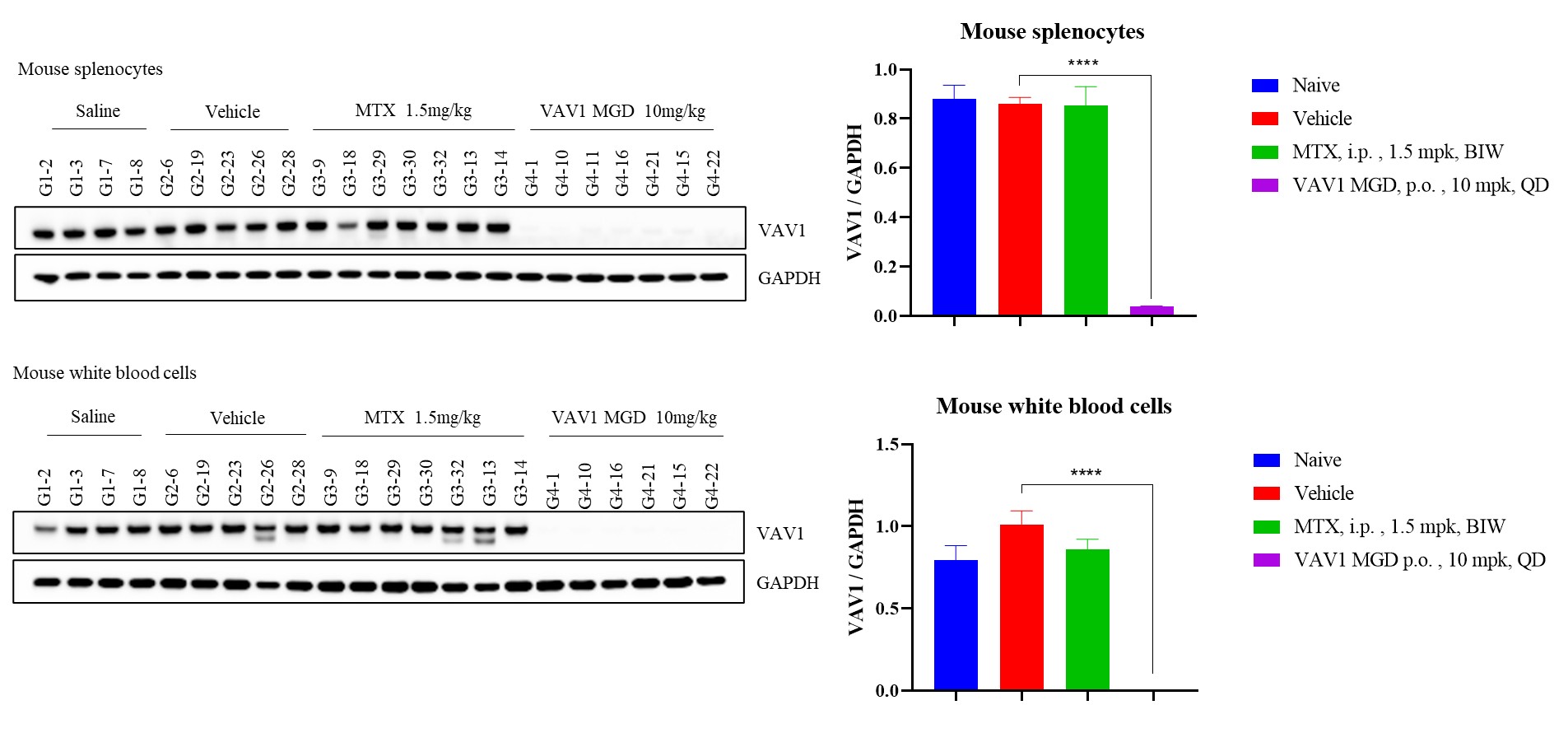Building on Part 1 (in vitro degradation, immune activation, and proteomics) and Part 2 (DMPK, safety and mechanism studies), this section evaluates in vivo efficacy and PD effects. The collagen-induced arthritis (CIA) mouse model — a well-established autoimmune model mimicking human rheumatoid arthritis — provides a robust system to assess anti-inflammatory efficacy. As VAV1 plays a key role in T cell signaling and cytokine production, it represents a compelling target for immune modulation. Here, we demonstrate that oral administration of VAV1 MGDs significantly improves clinical scores, reduces joint pathology, and downregulates inflammatory cytokines in CIA mice.
To evaluate the therapeutic potential of VAV1 MGDs in autoimmune disease, a CIA model was established in DBA/1 mice. Treatment with VAV1 MGD significantly reduced clinical arthritis scores, preserved grip strength, and alleviated joint pathology, demonstrating robust in vivo efficacy.

Figure 1. Therapeutic evaluation of VAV1 MGD in CIA mice. (A) Joint clinical scores on Day 21 show reduced paw swelling in VAV1 MGD-treated group. (B) Grip strength measurement after 20 days of treatment indicates improved muscle function. (C) Histopathological scoring of paw joints reveals alleviated tissue damage. *p < 0.05, **p < 0.01, ***p < 0.001 vs. vehicle group.
Typical pathological changes in CIA mouse paws were evaluated by HE staining. Histological scores were assigned across multiple categories including inflammatory infiltration, synovial hyperplasia, cartilage erosion, and bone destruction. Treatment with VAV1 MGD significantly reduced pathological severity across all parameters.

Figure 2. Representative histology and scoring of CIA mouse paws. Quantified pathology scores for different endpoints. (G1–G4) Corresponding HE-stained tissue sections from each treatment group: G1 – Normal; G2 – Vehicle; G3 – MTX; G4 – VAV1 MGD. Arrows indicate areas of pathological change. VAV1 MGD treatment showed clear histological improvement compared to vehicle and was comparable to MTX.
Western blot analysis of VAV1 protein levels in mouse splenocytes and white blood cells after 21 days of oral dosing. VAV1 MGD treatment led to near-complete degradation of VAV1, demonstrating strong in vivo target engagement.

Figure 3. Western blot bands show significant reduction of VAV1 expression in the MGD-treated group. Quantification confirms >90% degradation compared to vehicle and MTX treated group.
To further assess the pharmacodynamic effects of VAV1-targeting molecular glue degraders, serum levels of pro-inflammatory cytokines were measured in CIA mice following 21 days of treatment. Notably, IL-6 levels were significantly reduced in the VAV1 MGD-treated group (P < 0.01), indicating robust anti-inflammatory activity.

Figure 4. Serum IL-6 levels were significantly reduced in CIA mice treated with VAV1 MGD (P < 0.01), indicating effective suppression of inflammation.
This study demonstrates the in vivo efficacy of a VAV1-targeting molecular glue degrader in a CIA mouse model. The compound significantly alleviated joint inflammation and pathology, reduced serum IL-6 levels, and achieved near-complete VAV1 degradation in target tissues. These results support its therapeutic potential in autoimmune diseases and establish a strong pharmacodynamic link between VAV1 degradation and anti-inflammatory effects.
2025-10-30
2025-10-23
2025-09-28
2025-08-19
We value your inquiries and are here to provide you with tailored solutions for your drug discovery and development needs. Whether you have questions, require more information, or are interested in discussing potential collaborations, our team of experts is just a message away.
Feel free to reach out to us.